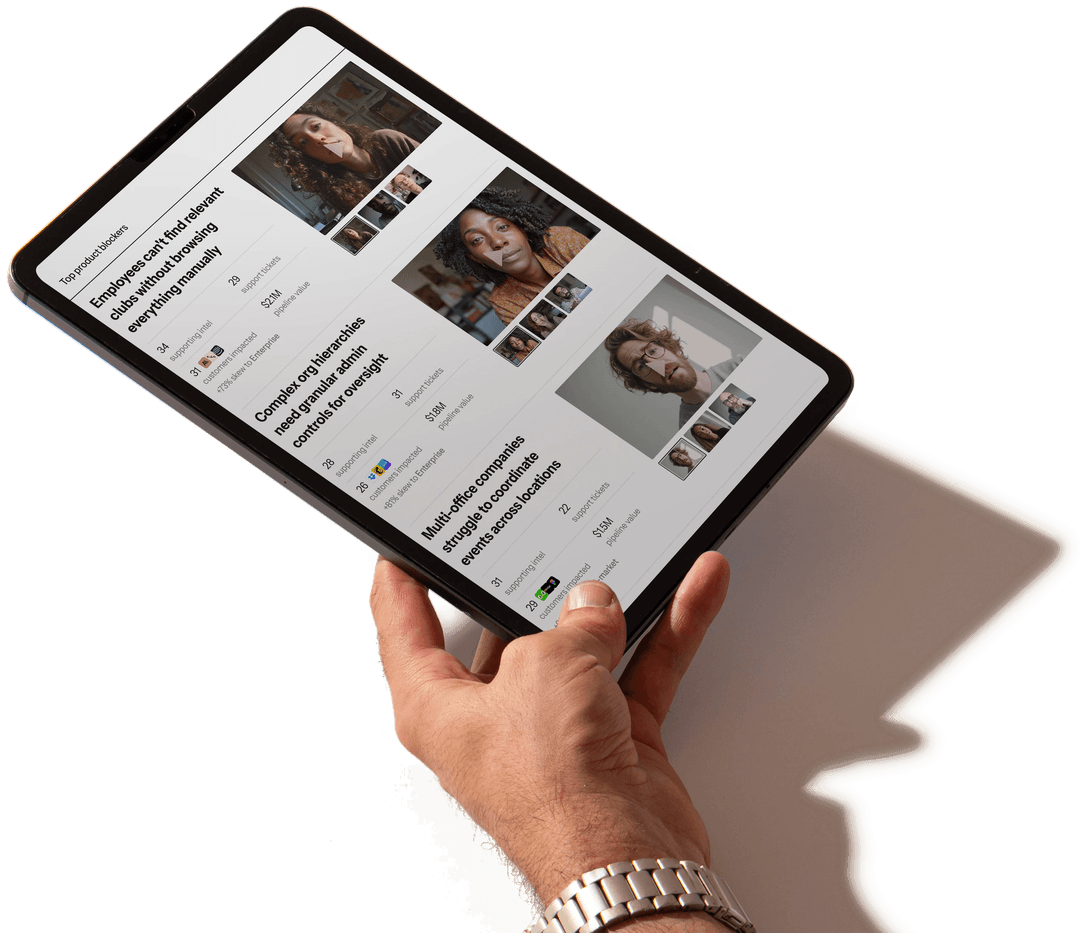
How Twine uncovered positioning opportunities by analyzing AI answers
Twine is a customer feedback intelligence platform that analyzes sales and CS calls to extract product gaps, competitive mentions, and deal blockers for product and GTM teams. Rather than immediately pursuing AI visibility, Twine used Hall to analyze how AI platforms described the conversation intelligence market—uncovering positioning gaps that informed their marketing strategy, product direction, and competitive differentiation.
The challenge: finding the right market positioning
Twine operates in the conversation intelligence space, where Gong dominates mindshare with “revenue intelligence” and Chorus claims the ZoomInfo-integrated alternative position. For a platform focused specifically on bridging product and GTM teams through customer feedback analysis, the challenge wasn’t just visibility—it was understanding how potential buyers actually thought about and researched solutions in this category.
Traditional competitive research would tell Twine what Gong and Chorus say about themselves. But that wasn’t the question that mattered. The real question was: when someone asks ChatGPT or Perplexity “what’s the best tool to analyze customer calls” or “alternatives to Gong for product teams,” what narrative were they hearing? And more importantly, were there gaps in how AI platforms framed the entire category?
Listening before positioning
Rather than immediately trying to increase AI visibility, Twine’s team took a research-first approach. They partnered with Hall to analyze how AI platforms discussed conversation intelligence tools, examining not just whether Twine was mentioned, but how the entire competitive landscape was being described and recommended to buyers.
Using Hall’s generative answer insights, the team analyzed hundreds of queries about conversation intelligence, call analysis platforms, and customer feedback tools. They weren’t looking for quick wins in citations—they were looking for insight into the buyer’s research journey and the mental models AI platforms were reinforcing.
The analysis revealed something unexpected. When people asked about conversation intelligence platforms, AI answers defaulted to a “sales coaching and revenue optimization” framing. The responses consistently positioned these tools as solutions for sales leaders trying to improve rep performance, forecast accuracy, and deal progression. Features like call recording, transcription, and coaching insights dominated the descriptions.
What AI platforms weren’t surfacing: the product team perspective. The challenge of getting customer feedback from sales calls into product roadmaps. The problem of feedback being trapped in sales reps’ memories or buried in CRM notes. The value of automatically extracting product gaps, feature requests, and competitive intelligence for product and marketing teams.
This wasn’t just a gap in Twine’s visibility—it was a gap in how the entire market conversation was being framed by AI platforms. Buyers asking about these tools were being steered toward a sales-centric narrative, even though many were actually trying to solve cross-functional feedback problems.
From insight to strategy
The AI answer analysis gave Twine something more valuable than citations: clarity on their positioning opportunity and a roadmap for competitive differentiation. The market conversation happening in AI platforms was missing the “product-minded conversation intelligence” angle entirely. Product managers, product marketers, and founders searching for ways to systematically capture customer feedback were being recommended tools built and marketed primarily for sales leaders.
Armed with this insight, Twine made strategic decisions across marketing, product positioning, and company direction. Rather than positioning as “another Gong alternative,” Twine owned the “AI-powered bridge between Product and GTM teams” positioning. Marketing content emphasized solving the “96% of customer feedback never reaches product” problem rather than just sales performance optimization. This differentiation came directly from understanding what AI platforms weren’t saying about the category.
The analysis revealed which product capabilities mattered most for differentiation. While competitors emphasized sales coaching and rep performance, Twine doubled down on features that served product teams: automated extraction of product gaps, competitive intelligence surfacing for product marketing, and systematic feedback delivery to roadmap planning. The AI analysis showed where competitors’ product narratives had blind spots.
Understanding that AI platforms defaulted to sales-leader personas helped Twine identify underserved buyers. Product teams, product marketers, and technical founders weren’t seeing their use case reflected in AI answers about conversation intelligence. Twine built targeted content and positioning specifically for these audiences, creating differentiation in market segments competitors were inadvertently ignoring.
The team identified specific query patterns where the sales-coaching framing fell short: “extract product feedback from sales calls,” “customer intelligence for product teams,” “competitive mentions tracking for product marketing.” These represented buyers whose needs weren’t being addressed by the dominant narrative, and Twine created content to own these positioning gaps. The competitive differentiation opportunities were clear: own the cross-functional conversation intelligence category, emphasize product-GTM alignment over pure sales optimization, and speak directly to buyers who were being underserved by existing market narratives.
The real win: strategic clarity
For Twine, the value of analyzing AI answers wasn’t about driving more citations or improving visibility metrics in the short term. It was about understanding the market conversation buyers were actually hearing and identifying where their specific value proposition fit—or didn’t fit—into that conversation.
The analysis revealed that Twine wasn’t just competing with Gong and Chorus for share of voice. They were competing with an entire market narrative that defined conversation intelligence through a sales-optimization lens. By understanding this, Twine could make strategic choices about where to invest in content, which use cases to emphasize, and how to differentiate in ways that actually matched how buyers were researching solutions.
Rather than fighting for mentions in “best Gong alternatives” queries where the sales-coaching framing dominated, Twine could establish their own category territory around product-GTM alignment and systematic customer feedback extraction. The AI answer analysis showed them where the market conversation had blind spots—and those blind spots represented their positioning opportunity.
About Twine
Twine automatically analyzes sales and customer success conversations to surface what matters to product and GTM teams.
Industry
Software
Website
Company size
5+ employees